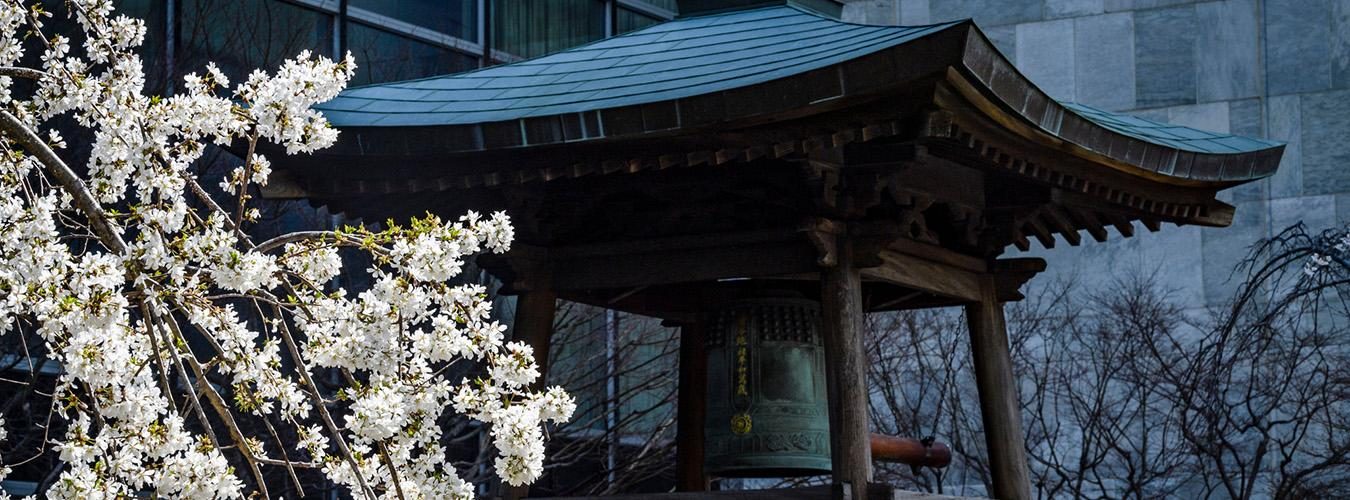
This year marks the 40th anniversary of the United Nations General Assembly declaration “International Day of Peace.” The purpose of the International Day of Peace was and still remains, to strengthen the ideals of peace around the world.
In 2001, September 21st was set as the annual day of commemoration – not only as a time to discuss how to promote and maintain peace among all peoples but most remarkably, as an annual 24-hour period of global ceasefire and non-violence for groups in active combat. https://www.un.org/en/observances/international-day-peace
The International Day of Peace reminds us of our commonalities. Regardless of where we come from or what languages we speak, we are more alike than we are different. Honoring those commonalities makes peace possible. Life is better in a world where peace exists. We draw on the wisdom and experience of the peacemakers and peacekeepers to learn how we can individually and collectively be catalysts for peace – how we can manifest a world that works for everyone, everywhere. Nations and communities around the world struggle with poverty and disease, severely limited access to education and healthcare, particularly in areas where violence is common.
There is something here much bigger than our day-to-day routines. We have the opportunity to transform the world so that our loved ones can live in sustainable peace. To achieve this we are called to step outside our comfort zones. Until we are willing to soften our own perspectives so we can catch a glimpse of someone else’s experience, peace will remain beyond our reach.
Peace is possible. The impact of each small act is immense. Imagine: If we were all simply kind and respectful of one another, how different life would be. We can all contribute to the worldwide culture of peace through generosity of spirit, prayer, advocacy, education and ensuring access to clean water and health resources. Every small effort makes a difference.
Throughout history, dating back to the Peace of God (989 AD) and Truce of God (1027 AD) we see movements that arose from the desire to curb violence by limiting the days and times nobility could practice violence. Most societies have lived in peace most of the time. Today, we are much less likely to die in war than our parents or grandparents. Since the establishment of the United Nations and the creation of the Charter of the United Nations, governments are obligated not to use force against others unless they are acting in self-defense or have been authorized by the UN Security Council to proceed.
Centers for Spiritual Living selected United Nations International Day of Peace in 2016, to conduct a ceremony at the Home Office in Golden, Colorado, to dedicate a Peace Pole and to formally recognize the Collective Meditation for Peace Initiative as an integral and essential element of our organization. The Heart of Peace Initiative coordinates weekly online Collective Peace Meditations and numerous events throughout the year.
At a Centers for Spiritual Living event in 2016, Rev. Dr. Kenn Gordon reminded everyone that every day must be dedicated to peace – that the consciousness of humanity must be uplifted to abiding in and as peace moment by moment. As he said, a Peace Pole is a material replica of the intention that has brought it into form, just as the actions we take demonstrate Spirit’s call to do our part to manifest a world that works for everyone. World peace is a product of what is in the hearts of individuals. To achieve world peace, we must begin with the individual. In order for us to experience and express peace, we must first reveal that peace from within us – to remove all obstacles to the free flow of peace and love.
Religious Science has always been a powerful presence for peace, a core attribute of our philosophy of Oneness. As Dr. Ernest Holmes explained in Spiritual Awareness, “When we become conscious of our existence as an idea in the Mind of God, we shall find that we are walking in pathways of peace; that something within us acts like a magnet to attract that which belongs to itself. This something is Love, the supreme impulsion of the universe.”
Today more than any other time in history, peace relies on the commitment to not only achieve equality, but to secure equity for all persons – to fulfill our vision of a world that works for everyone, everywhere.
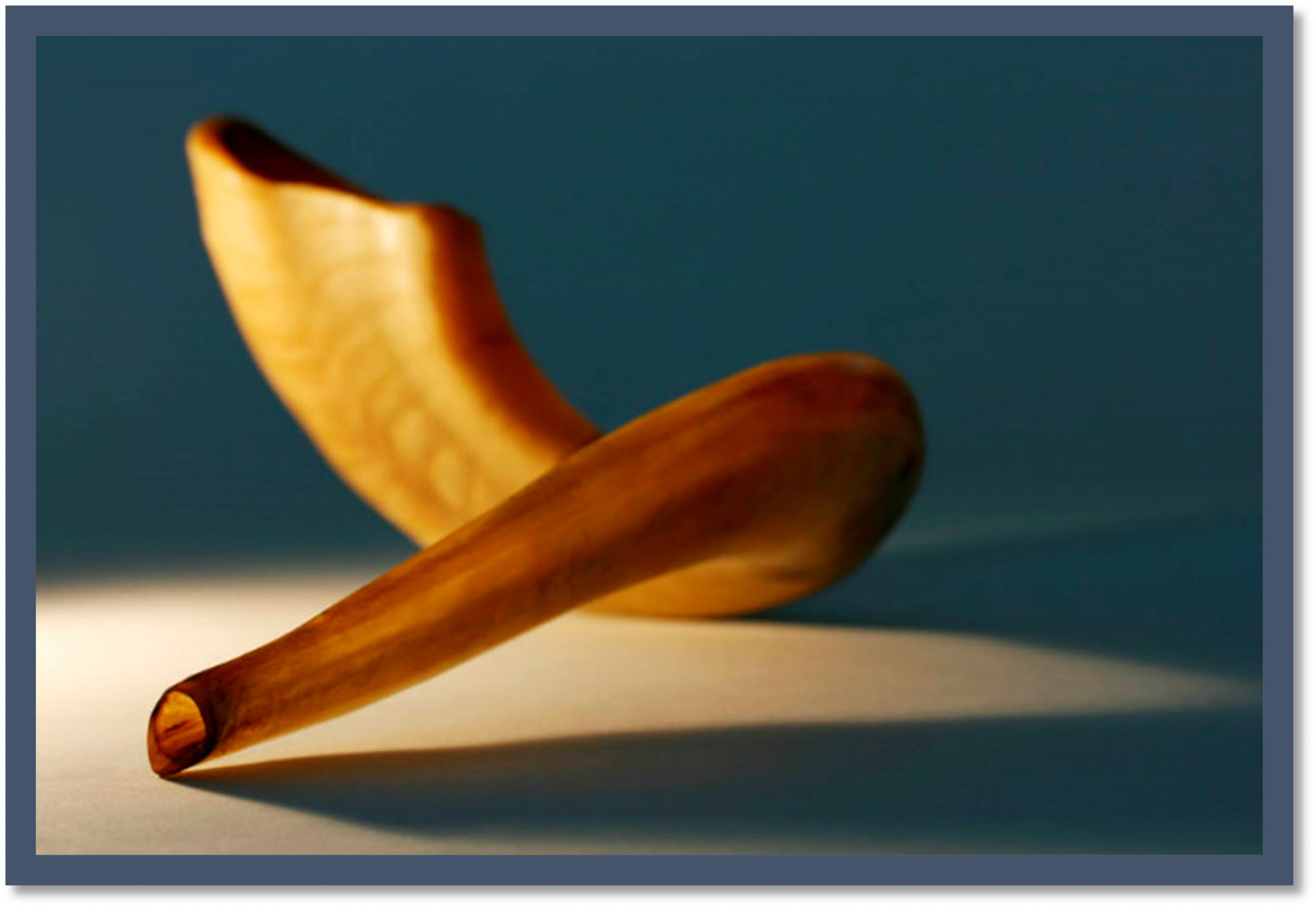
The Jewish High Holidays begin with the celebration of Rosh Hashanah the evening of Monday, September 6th and end with Yom Kippur at sundown Thursday, September 16th. The High Holidays are a time when many Jews make their strongest identification with Judaism, with their congregation, and with the Jewish people.
These ten days between Rosh Hashanah and Yom Kippur are known as the “Days of Repentance.” The holidays are celebrated in accord with the lunar-solar cycle. Consequently, on the Gregorian calendar the dates move annually. You might hear Jews describe this year’s High Holidays as “early.”
Rosh Hashanah literally means in Hebrew, “the head of the year.” The Erev (Eve) Rosh Hashanah service Sunday evening sets the stage to welcome the Jewish new year of 5782. It is also when the “Book of Life” is opened and is left open during the days of repentance. Jews are encouraged to identify things they have done wrong, might have done better, and to express sorrow for them, expressing sorrow to those affected. Hence the name “the Days of Repentance.” At the dramatic concluding Yom Kippur service, the Book of Life is symbolically closed for another year.
In Reform Jewish Congregations, the Erev Rosh Hashanah service is following by a full day of worship, this year Tuesday, September 7th. In Conservative and Orthodox Jewish Congregations, there is an additional day of Rosh Hashanah observance on Wednesday, September 8th.
These services feature special prayers delivered in a special High Holiday “trope” or chants; melodies heard only this time of the year. The music is soaring, the prayers special, the sermons special, with much of the worship experience dating back centuries. The Rosh Hashanah services conclude with the blowing of the shofar, or ram’s horn. This signals that we have all come together as the Jewish people once more, it marks the beginning of a new year, and that this is the time to commit to doing better in the year ahead.
During this time Jews will set our plates of apples and honey, the apples representing our world and the honey the sweetness of the new year. This is also the only time of the year that one has round challahs rather that the traditional loaf for services and at home. Again, the round challah represents the globe and recognizes this time as the birthday of the world.
The days following this service and leading up to Yom Kippur are to be a period of introspection. It is to be a time for “teshuva,” or turning around, identifying how one can do better.
On Yom Kippur, or the Day of Atonement, these commitments are entered into the figurative Book of Life. From Erev Yom Kippur (Eve of Yom Kippur) through the next day the worship experience is solemn and serious. If one’s health allows, it is traditional that Jews fast from the start of the Erev Yom Kippur service through sunset of Yom Kippur service. The holiday concludes with a Break the Fast meal, often with family and friends.
For those who have fulfilled the mitzvah, or commandment, to observe these holidays, one leaves with a renewed sense of purpose, of commitment, and of peace.
The traditional greeting to Jews during this High Holiday period is to wish one another a happy new year. In Hebrew this is, “Le Sha-nah To-vah.” It means literally, “Happy New Year.” One can also say, “Yom Tov,” happy holiday, and on Yom Kippur, wish one an easy fast.
May this year’s Days of Repentance be a time of sincere renewal, commitment, and peace for all. “Le Shanah Tova!”
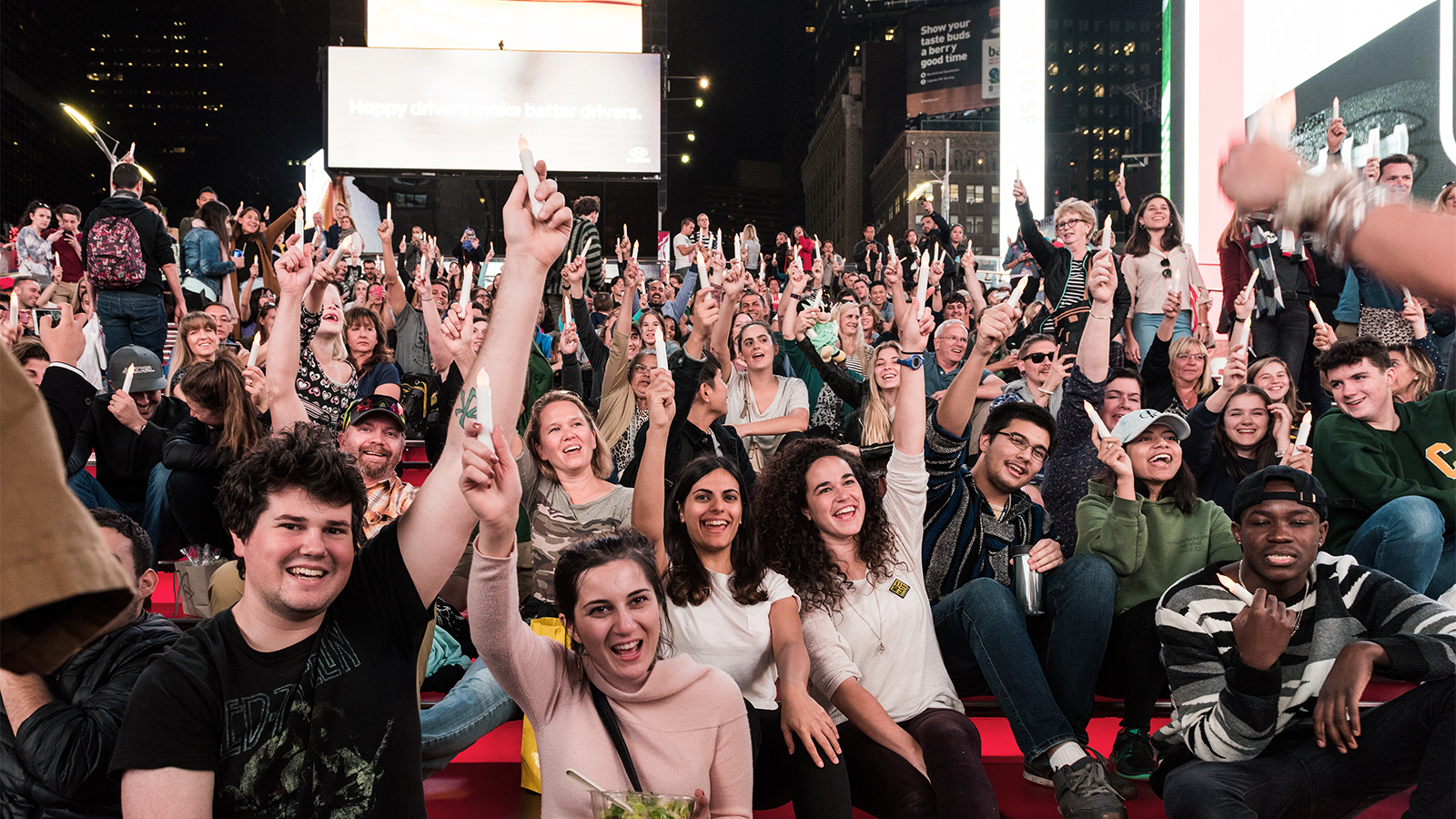
A recent survey of religion in America provides some granularity when it comes to the so-called decline in religiosity in these United States. Survey: White Mainline Protestants Outnumber White Evangelicals
The data show that contrary to other research, the percentage of Americans identifying with formal denominations is on a rebound from a low in 2018. Is this good news? Well, there’s a lot to be said for maintaining a skeptical attitude about formal religion. And yet, at the same time, this modest (re)turning to organized religion may be a response to the spiritual void that “mass society” represents.
Philosopher, and deeply agnostic, Hannah Arendt, summed up “mass society” thus:
All of the features, however, that mass psychology has by now identified as typical of man in mass society: his abandonment (Verlassenheit—and this abandonment is neither isolation nor solitude), along with his utmost adaptability; his irritability and lack of support; his extraordinary capacity for consumption (if not gluttony), along with his utter inability to judge qualities or even to discern them; but most of all his egocentrism and the fatal alienation from the world that he mistakes for self-alienation (this, too, dates back to Rousseau)—all of this first manifested itself in “good society,” which does not have a mass character. The first people of the new mass society, one might say, constituted a mass to such a small degree (in a quantitative sense) that they were actually able to consider themselves an elite.
One could argue that, with a few exceptions in Northern Europe, Americans represent the elites of the world. We are enmeshed in the ills outlined in this dense paragraph from Arendt’s critique of mass society, and it is natural to crave for some sort of spiritual solace. Most of us in Tysons Interfaith would probably quibble with the word “solace,” because that seems like a psychological cop out. Our faith traditions emphasize the Platonic world view that ideals, like good and evil, are real.
I believe that the beauty of religious worship is its communality. Megachurches excepted, most worship takes place in an intimate setting where loving relationships can be forged between individuals of different backgrounds and tendencies. This is what I experience in my faith community and with my participation in Tysons Interfaith. If you want to read about communality in action, I recommend to you the life of Gordon Crosby, who bucked the trend of bigness and put social responsibility front and center in his theology. Rebel pastor Gordon Cosby left lasting mark on mainstream Christianity – The Washington Post.
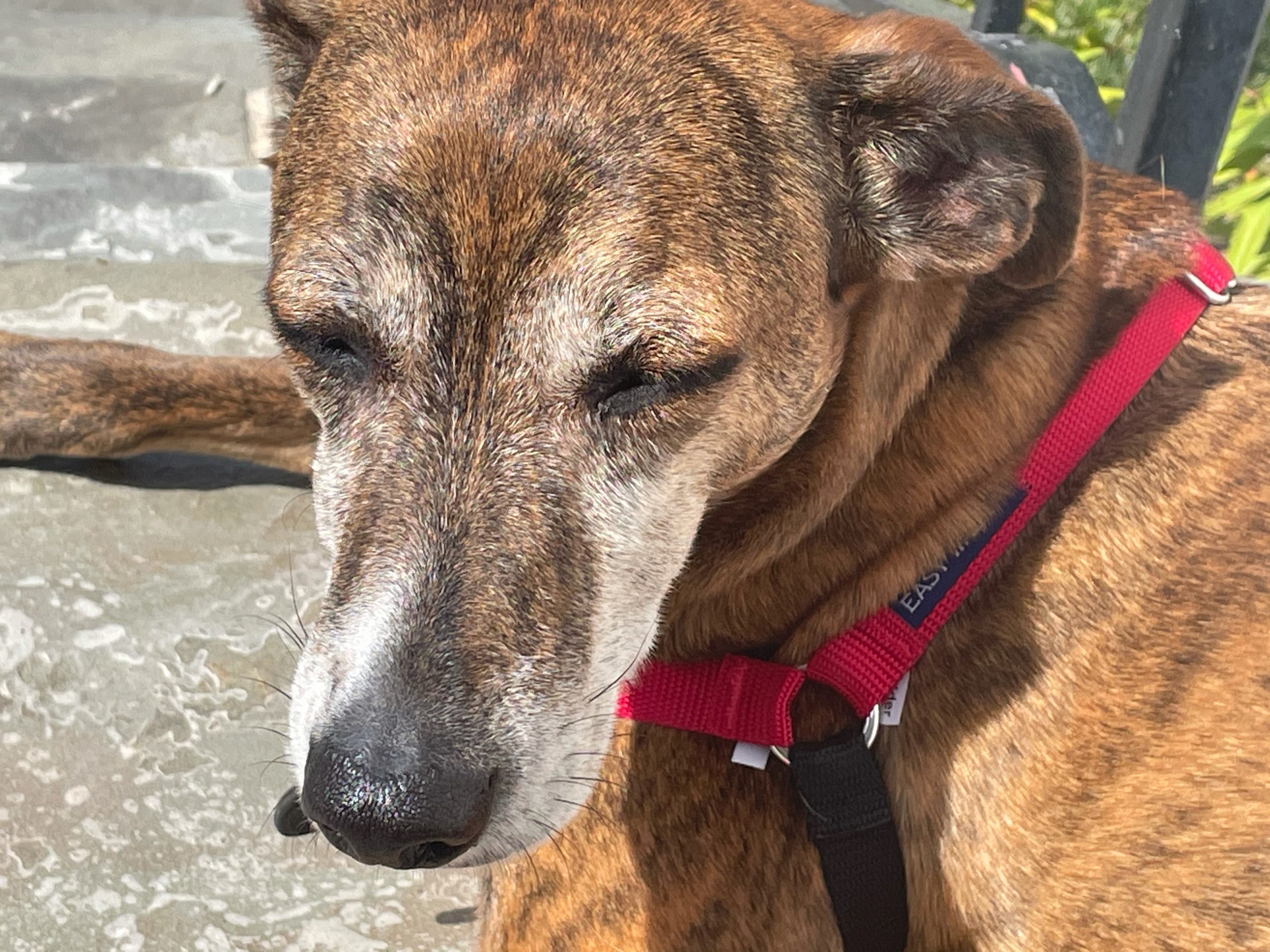
“The zealously nurtured attitude of literal credulity towards the oriental treasure of thought is in this case a lesser danger, as in Zen there are fortunately none of those marvelously incomprehensible words, as in Indian cults. Neither does Zen play about with complicated Hatha-yoga techniques, which delude the physiologically thinking European with the false hope that the spirit can be obtained by sitting and by breathing. On the contrary, Zen demands intelligence and will-power, as do all the greater things which desire to become real.”
Thus, no less a thinker than Carl Jung ends his foreword to D.T. Suzuki’s essays on Zen, first published in Japan during the “1914 War.” The eminent psychologist takes more than twenty pages to dance around an explanation of what the Japanese call Satori, translated imperfectly as “enlightenment” in most “Western” treatises. If he can’t do it, with all the usual qualifications, then how can a hopelessly European male living on the outskirts of Tysons do so in the 21st century?
Well, let’s start with a classic Wu- or Mu-anecdote about the dog. A monk once asked: “Has a dog Buddhist nature, too?” The Master answered: “Wu,” which Jung explains is “obviously just what the dog himself [in my case, herself] would have said in answer to the question.” It usually comes out as “woof.”
Without “making any recommendation or offering any advice,” Jung says that when Westerners begin to talk about Zen, he considers it his “duty to show the European where our entrance lies to that ‘longest of all roads’ which leads to satori, and what difficulties strew that path, which has only been trodden by only a few of our great men [sic]—perhaps as a beacon on a high mountain shining out in the hazy future.” It “can neither be captured in with skillful formulae nor exorcized by means of scientific dogmas, for there is something of Destiny clinging to it—yes it is sometimes Destiny itself, as Faust and Zarathustra show all too clearly.” Well, it’s not so clear to me since I don’t really understand German.
He goes on to warn that these two great works “are only on the border-line of what is comprehensible to the European” and “one can scarcely expect a cultured public who have only just begun to hear about the dim world of the soul to be able to form any adequate conception of the spiritual state of a man [sic] who has fallen into the confusions of the individuation process, by which term I have designated the ‘becoming whole’ (Ganzewerdung).”“Preoccupation with the riddles of Zen may perhaps stiffen the spine of the faint-hearted European, or provide a pair of spectacles for his short-sightedness, so that from his ‘gloomy hole in the wall,’ he may enjoy at least a glimpse of the world of spiritual experience, which until now has been shrouded in mist.”
Well, I can tell you that early in the morning on the Jones Branch Extender by the Capital One building, there are indeed mists to contemplate. And there are plenty of dogs being walked about by happy denizens all around Tysons. So, woof. Or should I say, “Wu”….?
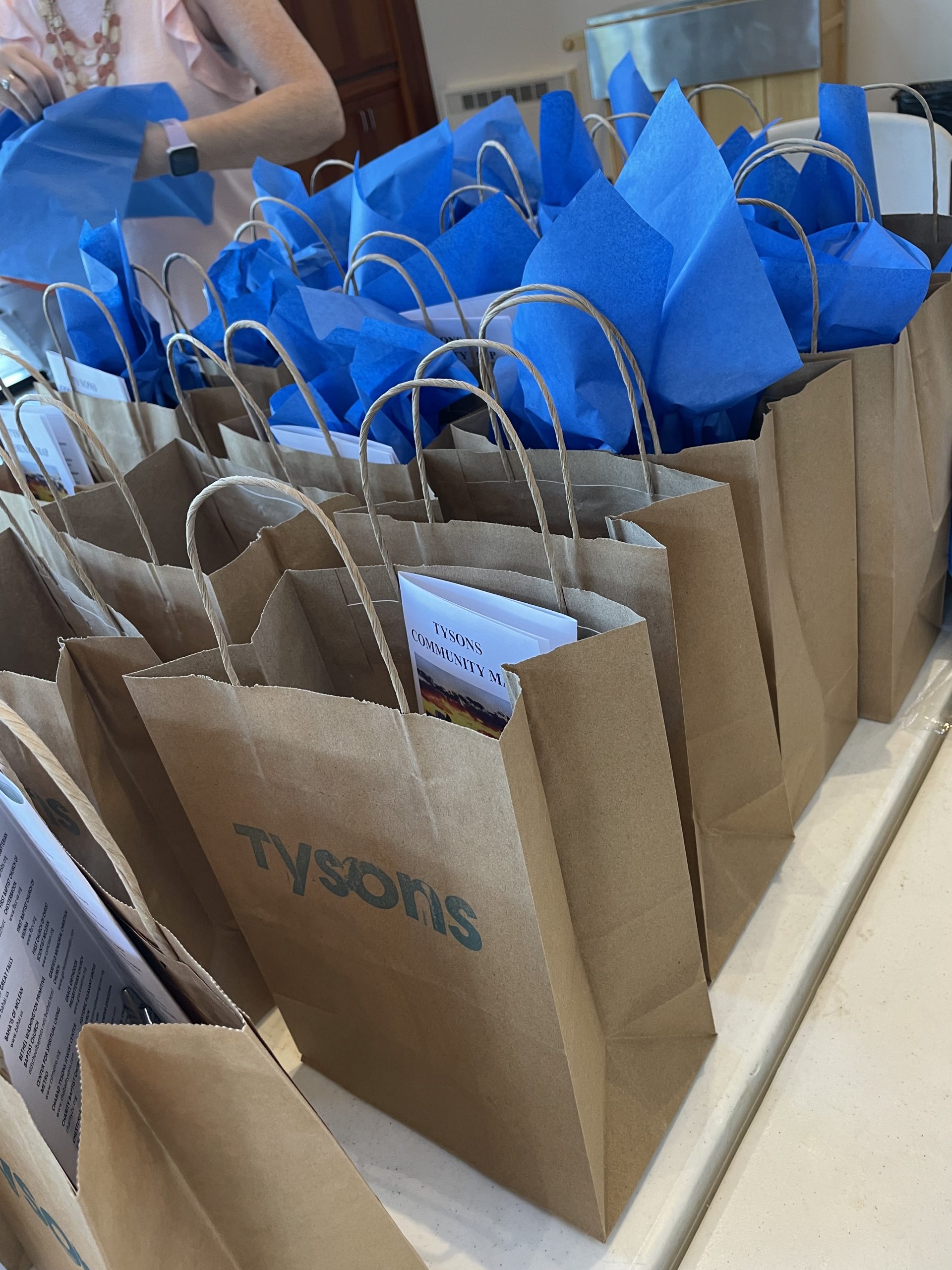
In December, when I started at Emmanuel Lutheran in Vienna as their associate pastor for evangelism and mission, I joined Tysons Interfaith right away. As someone entering my 10th year of ordained ministry, I have been part of a few ecumenical groups over the years, but this one is unique. As I attended our zoom meetings over the last year and participated in TI’s various discussions and forums, I’m so inspired by the work and passion that is happening in this group, despite the pandemic and its limitations.
At the end of July, I was finally able to meet some of the other members of Tysons interfaith in person, at Redeemer Lutheran in McLean to assemble “Welcome Bags” for new residents in Tysons. Our idea is to provide these bags to many of the major condominiums and apartment complexes in Tysons, to give away as new people move in. Inside each bag is a pen, magnet and lens cleaning cloth with the TI logo, a map of the community that includes a list of congregations in the surrounding area, a metro map, and a small package of tissues (because, pandemic!). We hope that new residents not only feel welcomed and connected to the community, but also learn that TI and these faith communities are ready resources. These bags will be going out in the next few weeks, to create a sense of connection and inclusion to the newcomers in our midst.
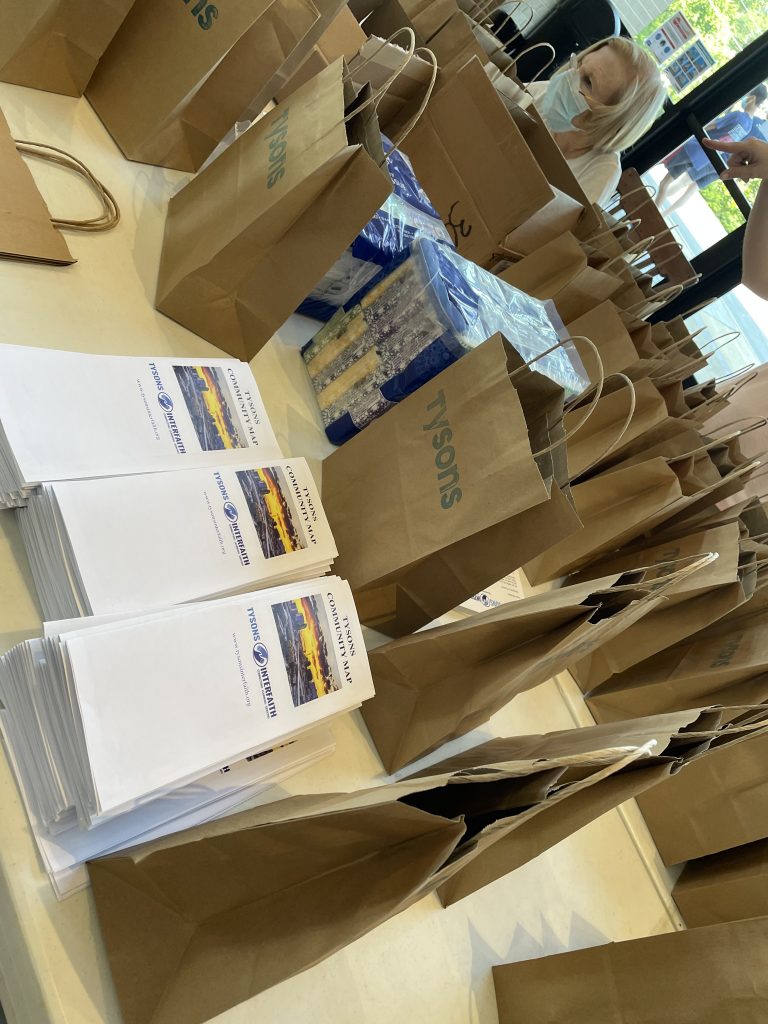
As someone still fairly new to NOVA, I’m so appreciative to have this group of passionate colleagues to work along with, and I am relieved that none of us are doing this alone. As a Christian and as a Lutheran, I believe that God is already present and at work in the community of Tysons, and God is continually inviting us alongside this work, as fellow participants. I’m thrilled to be along for the ride!
This blog post is the expressed opinion of its writer and does not necessarily reflect the views of Tysons Interfaith or its members.
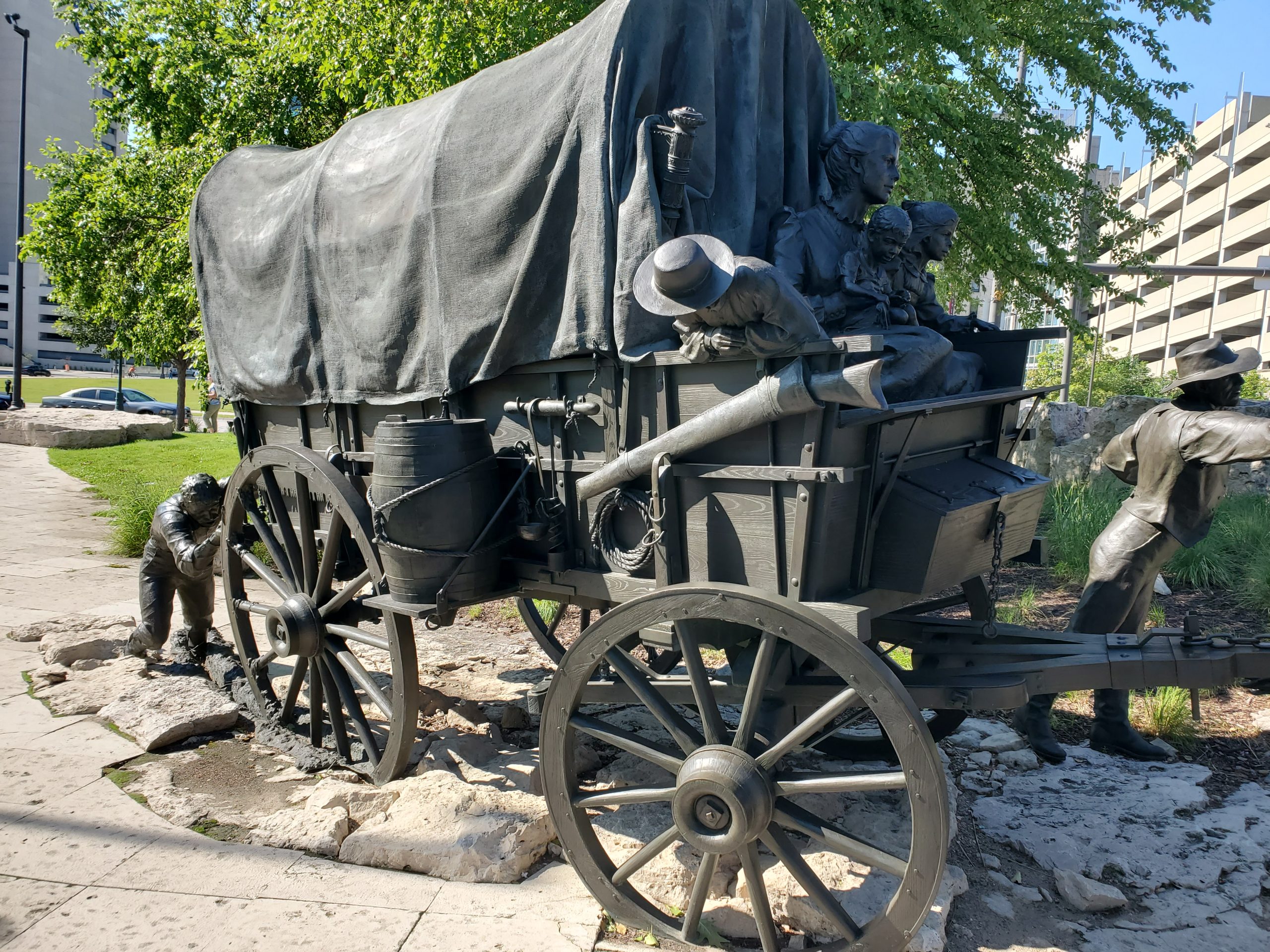
Every July 24, the State of Utah celebrates Pioneer Day, a major state holiday. Pioneer Day commemorates July 24, 1847, when an early contingent of Mormon pioneers, led by Brigham Young, entered what is now the Salt Lake Valley. They had made a long trek to find a place of refuge from religious persecution. The holiday is marked in many Utah cities and towns by a parade with pioneer-themed floats.
On a recent road trip through the West, we saw some key points along the trail that led to the settlement in Utah. The first was Winter Quarters (current day Omaha), the embarkation point where the Mormon pioneers spent two winters preparing for the trek west. Downtown Omaha has an extensive monument to the Mormon and other pioneers that went west in wagons, on horses, or on foot pulling handcarts. There is also a cemetery where 600 of the 4,000 Mormon pioneers who spent those difficult winters are buried – they didn’t make it west. Overlooking the cemetery is a powerful bronze sculpture commemorating the sacrifices and faith of those pioneers – by sculptor Avard Fairbanks, who coincidentally sculpted the busts of George Washington that frame the campus of George Washington University. The sculpture is placed directly over the graves of an unknown child and seven other pioneers.
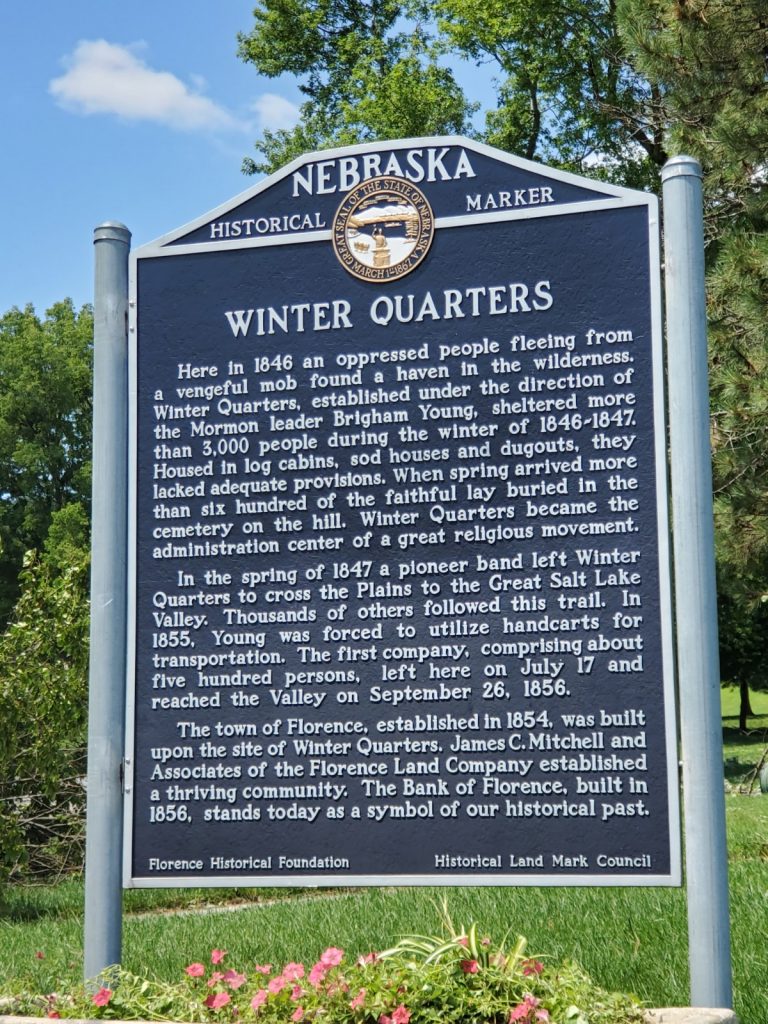
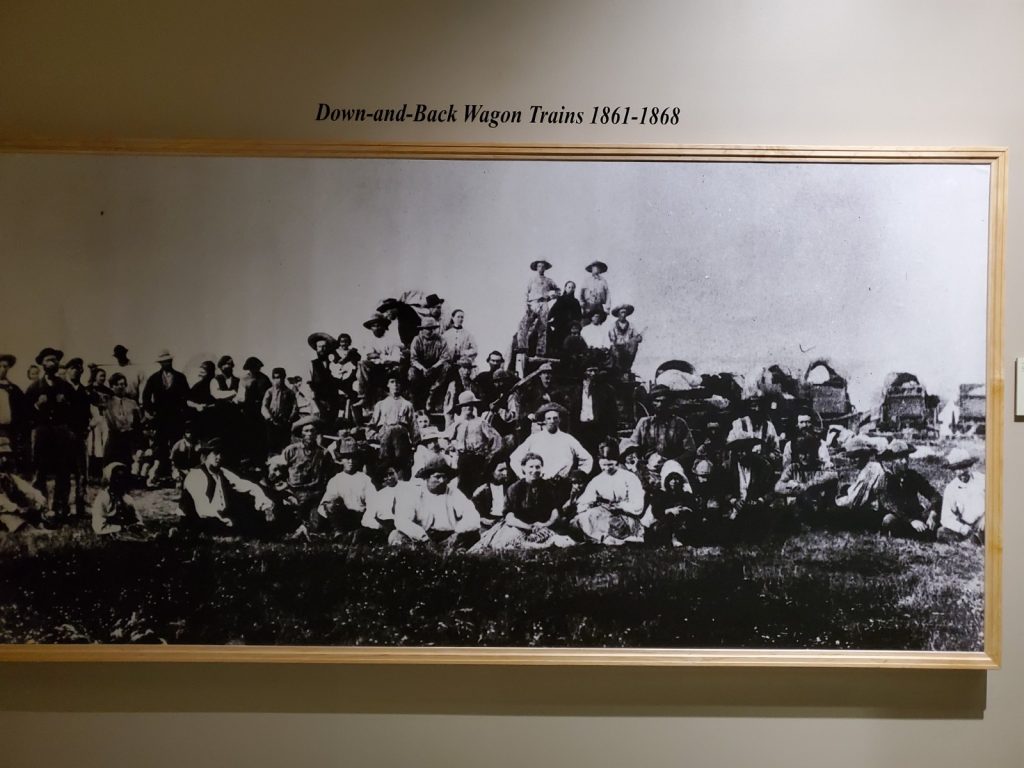
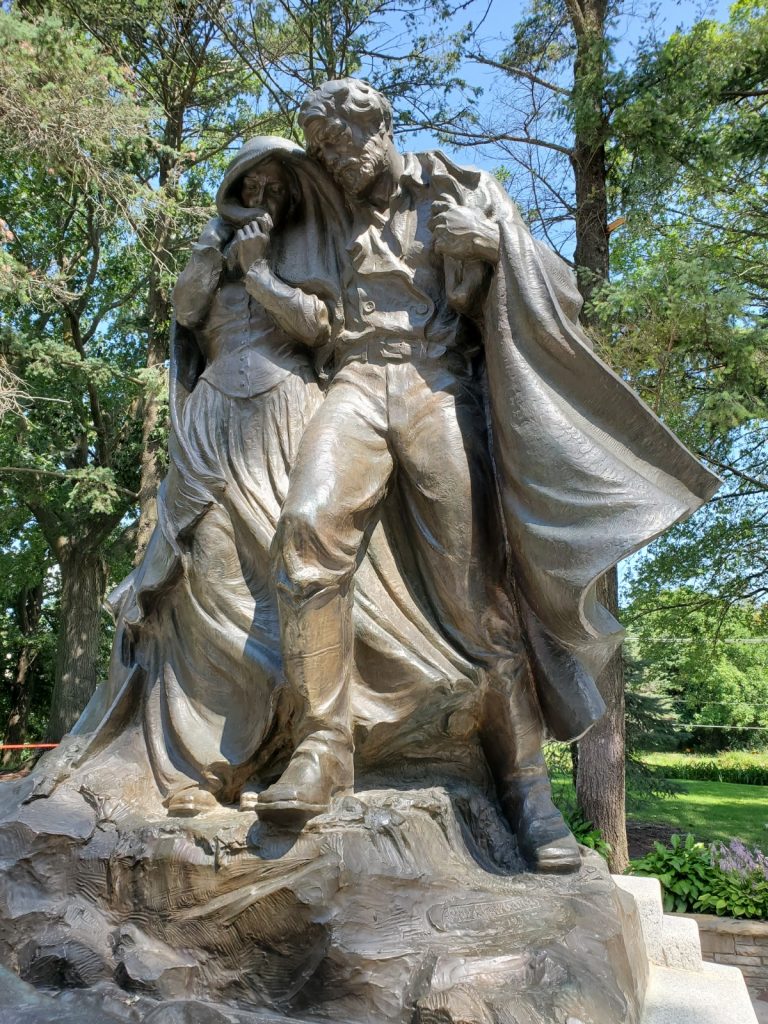
About 450 miles to the west is Chimney Rock in the North Platte River Valley. Not only is it the most recognizable landmark on the Mormon Trail (and the Oregon Trail that parallels it) because of its unique shape, it also marks the end of the flat part of the trail and the beginning of the mountainous terrain that culminates in the Rocky Mountains. Near Chimney Rock is a grave marker for Rebecca Winters, a mother of 4 who died from cholera along the trail. It was very moving to see that a family friend had taken the effort to carve her name in an old wagon wheel to memorialize her sacrifice and her importance as an individual. Her descendants later added a more traditional grave marker.
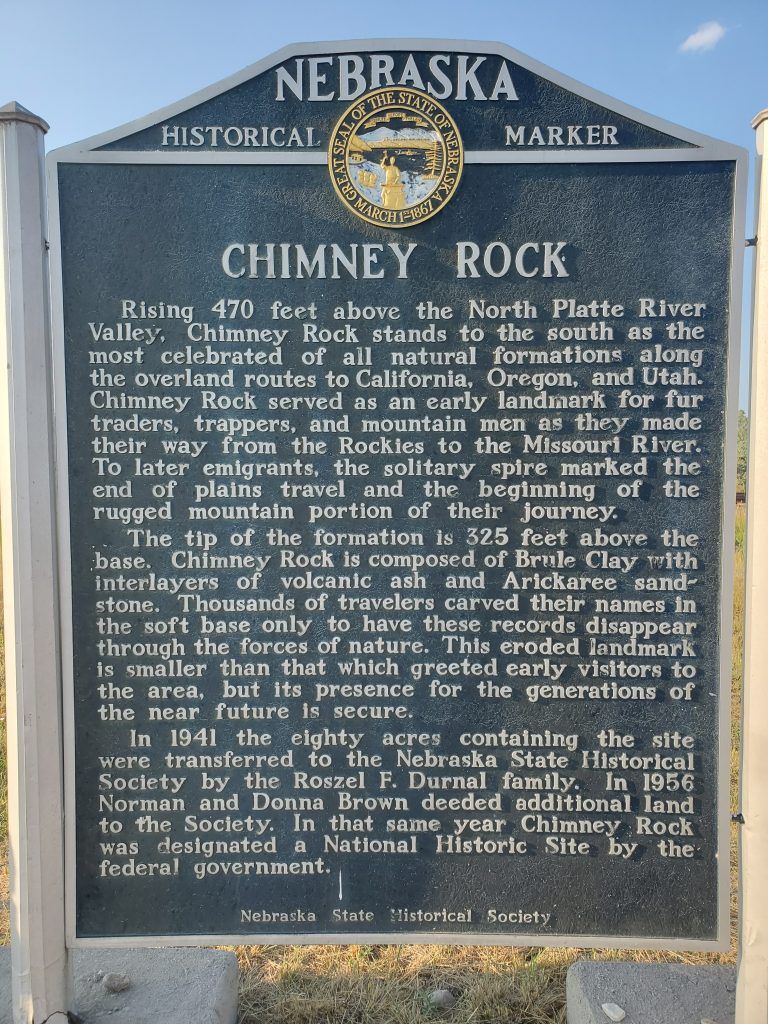
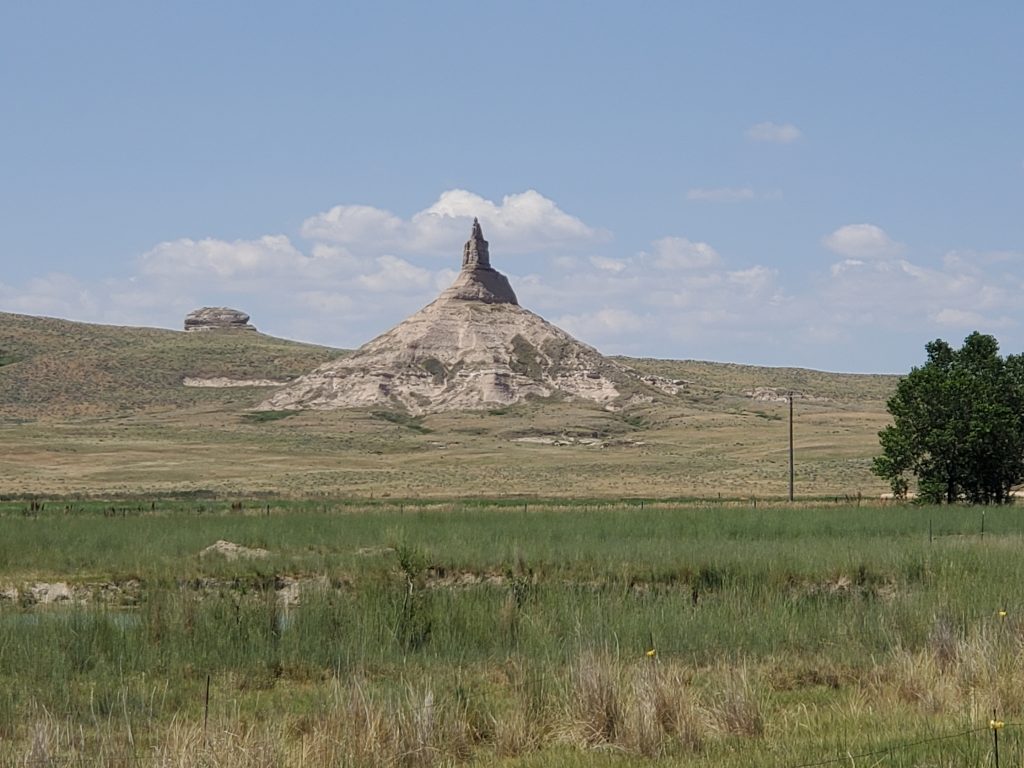
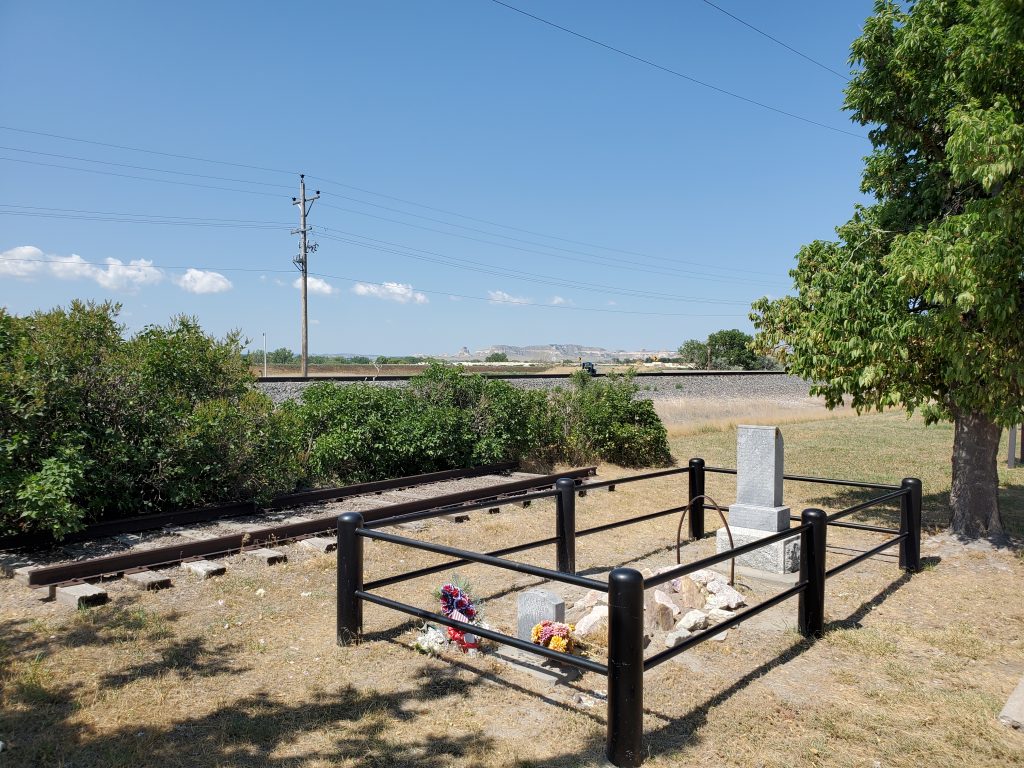
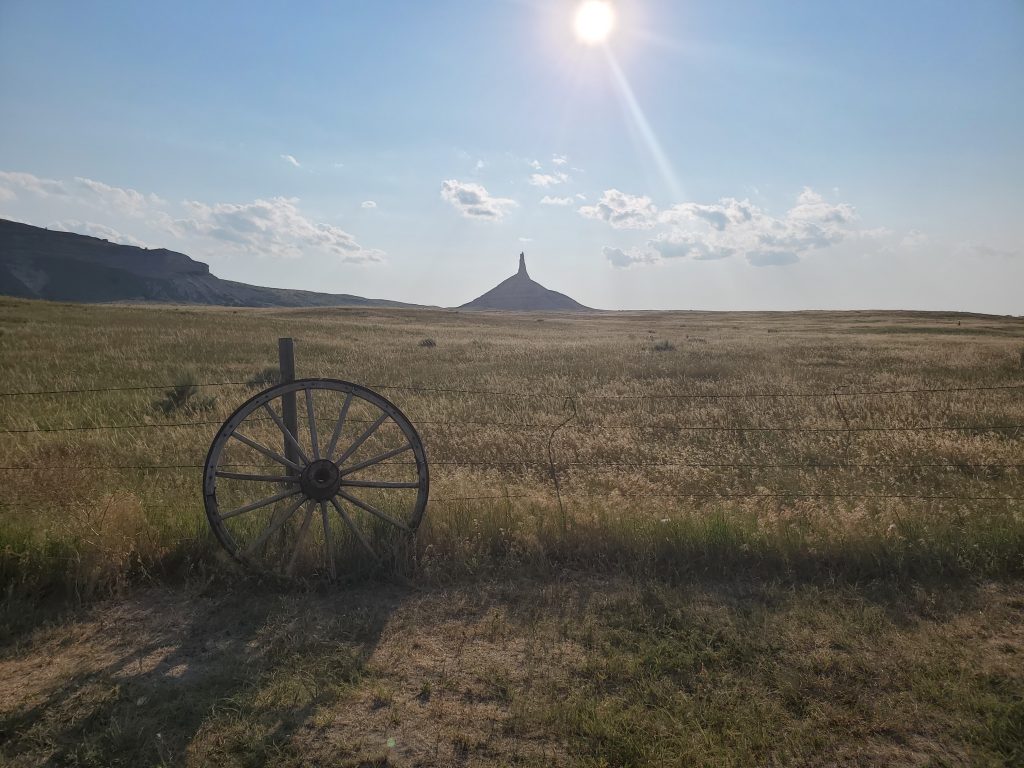
The Mormon Trail is sacred ground for members of our church, the Church of Jesus Christ of Latter-day Saints. Both of us have ancestors who were among the 70,000 that went west, through great hardship, to find a place of peace to live and worship. What motivated these pioneers to make this dangerous trek? As one of our church leaders summarized a few years ago:
“The foremost quality of our pioneers was faith. With faith in God, they did what every pioneer does – they stepped forward into the unknown: a new religion, a new land, a new way of doing things . . . Two companion qualities evident in the lives of our pioneers, early and modern are unselfishness and sacrifice.”
This blog post is the expressed opinion of its writer and does not necessarily reflect the views of Tysons Interfaith or its members.
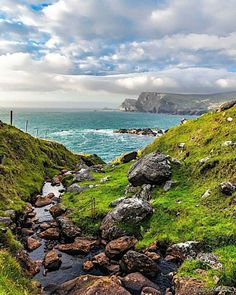
Someone once told me, I don’t know if it’s true, that the Tao Te-ching (Dao De Jing) the classic of Chinese Taoism (Daoism) has been translated more times than the Bible. Well, here’s my translation of the first few lines, modified from that of the great Christian missionary, James Legge, whose poetic rendering of the middle lines I leave intact:
The Tao that can be spoken of is not the enduring and unchanging Tao.
The name that can be named is not the enduring and unchanging name.
The unnameable is the Originator of heaven and earth;
the nameable is the Mother of all things.
Always without desire we must be found,
If its deep mystery we would sound;
But if desire always within us be,
Its outer fringe is all that we shall see.
Evolving from these two aspects, which are really the same,
we differentiate them.
Together we call them the Mystery of Darkness.
Where the Darkness is the deepest is the gate of all that is subtle and wonderful.
Until recently, the Chinese have followed the ideas and beliefs of Confucius, who did not have much time for religion, which he mocked once as being overly concerned with “ghosts.” But right from the outset, and this was a very long time ago, the Chinese knew something was missing, so a group of mystics grew up in radical opposition. And later the Chinese embraced Buddhism until finally the Confucians threw in the towel and created a synthesis called Neo-Confucianism, which lasted until the Communist Revolution.
Well, Confucius also said,
“At fifteen, I had my mind bent on learning. At thirty, I stood firm. At forty, I had no doubts. At fifty, I knew the decrees of Heaven. At sixty, my ear was an obedient organ for the reception of truth. At seventy, I could follow what my heart desired, without transgressing what was right.”
I’m not quite seventy, but I’ve been receiving a lot of truth lately, so here comes my take on the Mystery of Darkness and nothingness.
From the Jewish commentary on the first lines of Genesis, we have the following:
Rav said . . . In customary practice, when a king of flesh and blood builds a palace on sewers, dung, and garbage, if someone comes and says, “This palace is built on sewers, dung, and garbage,” does he not pronounce it defective? So too, if someone comes and says, “This world was created out of chaos and waste [tohu wa-bohu],” does he not pronounce it defective? Rabbi Huna said in the name of Bar Qappara: Indeed if the thing was not written in Scripture it would be impossible to say it! “In the beginning God created heaven and earth”—Out of what?—“the earth was chaos and waste [tohu wa-bohu].”—Genesis Rabbah 1:5
So, in both the Judeo-Christian and Chinese tradition there was a primordial darkness, void, or apparent chaos at the beginning of creation. What God’s followers have been trying to do ever since is to advance God’s perfect kingdom on earth. The Taoists believe, apparently, that this is folly, because good and evil are bookends, like Yin and Yang. And the Buddhists warn that all is suffering. For the People of the Book, and that includes our Muslim sisters and brothers, this simply will not do. Where there seems to be agreement among the traditions, however, is a deep and abiding respect for the “Originator of heaven and earth.”
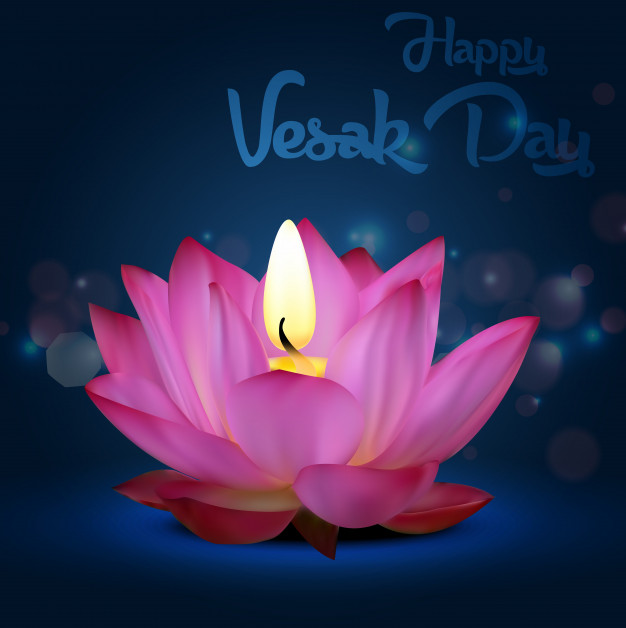
Buddhist holidays are a little bit confusing because different traditions recognize different dates, but…
The biggest and most important holiday celebrated by all Buddhist schools is called Vesak (Vesakha), along with some other local names. All Buddhist schools agree it’s the Buddha’s birthday. Two out of the three major lineages recognize it as the Buddha’s birthday, enlightenment day, and the day of his passing away. It’s traditionally celebrated on the day of the full moon in May (this year May 26), but celebrations occur throughout May and early June.
On Vesak Day the Buddhist temples are decorated with flags and flowers, and devotees assemble in temples for ceremonial rituals. There are often candlelit processions in the evening. Buddhists pay homage to Buddha by following his teachings. On Vesak, Buddhists try to practice love, peace and harmony by participating in volunteer and civic activities that benefit all humanity.
If you have a Buddhist friend, feel free to wish them a fruitful and spiritually refreshing Vesak Day on May 26th.
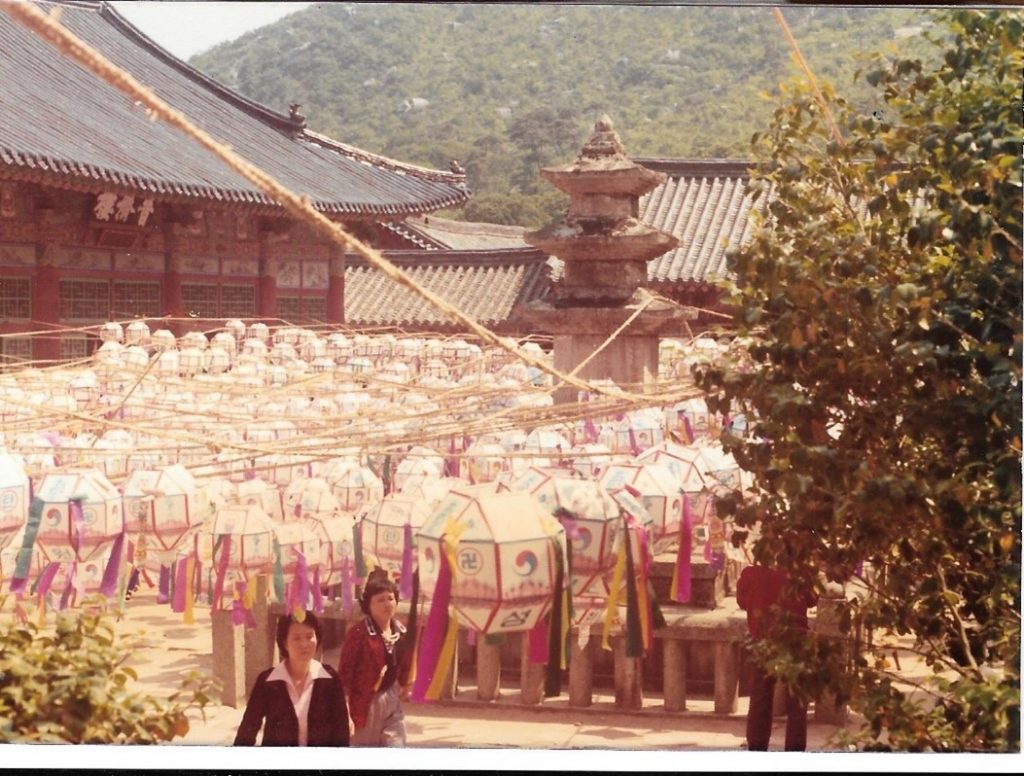
Buddha’s birthday in Busan at Jinjing Temple, circa 1977
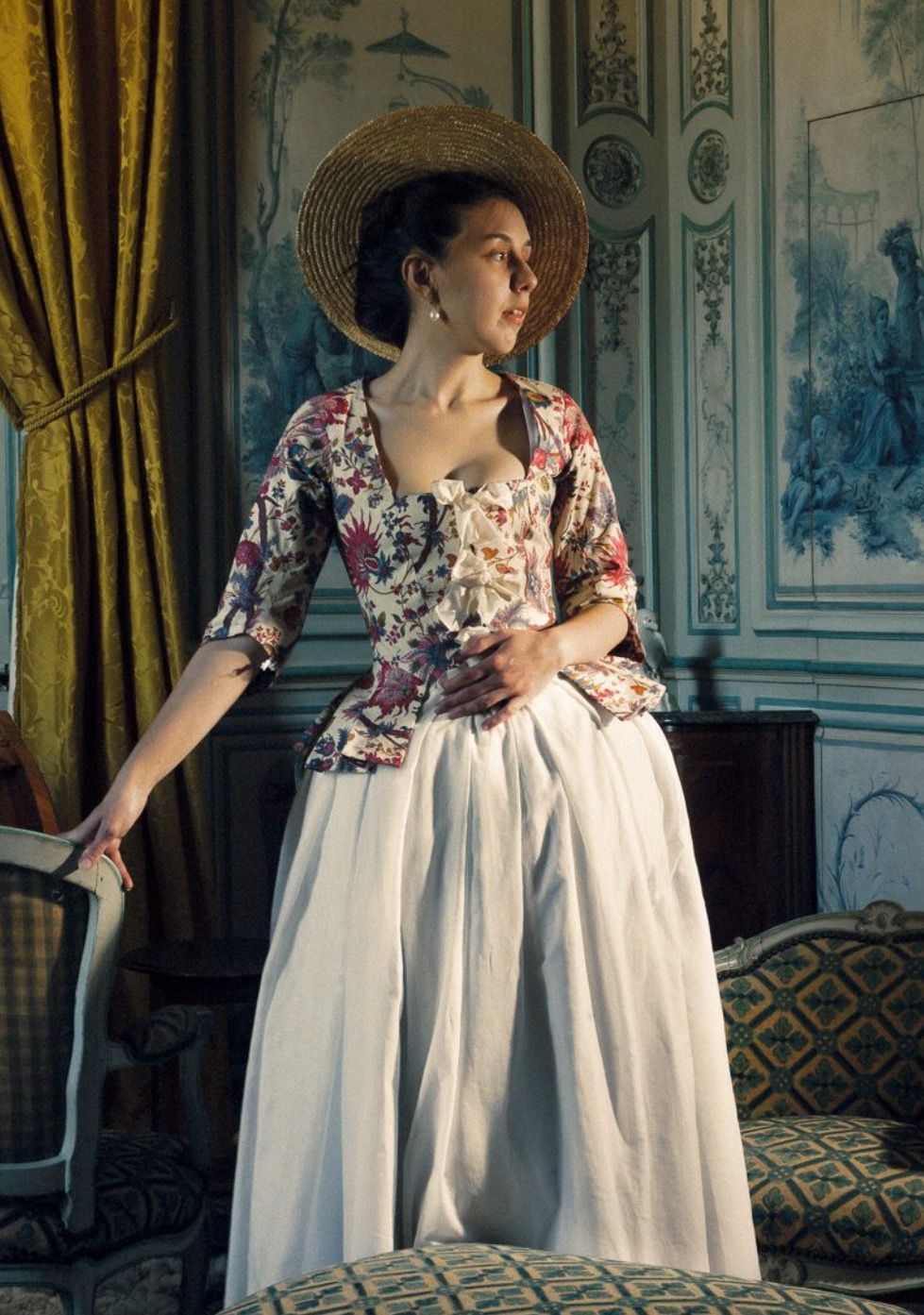
During the most locked-down parts of the pandemic, I didn’t write a book, start a new hobby or make bread. I ate a lot of carbs, sewed some masks, and went on a months-long internet deep dive into historical fashion.
To help me face long days of pandemic ministry, the stress of tech problems, and wading through worship safety precautions, I turned to YouTube to de-stress. I found myself watching more and more (Euro- and US – centric) historical fashion YouTube channels, specifically covering roughly 1790 – 1900, such as Bernadette Banner and Abby Cox, plus following Instagram accounts such as “Not Your Mamma’s History.” As I binged these channels to escape the general pandemic mental breakdown, I started noticing time periods in films based on women’s clothing shape and style.
Fast forward to our current era, spring of 2021, and some of us are emerging from the covid cocoon. Many of us, myself included, are trying on our professional clothes that have not seen the light of day in an entire year… and discovering not everything fits the way it used to. I see post after post all over social media lamenting how our bodies have changed during the pandemic. Even those of us who intentionally attempting to have better relationships with our bodies, myself included, are struggling. Many of us find ourselves in need of new clothes, but this is not a reason for a new wardrobe that our culture has deemed to be “fun” or “good.”
I want to let you in on some timely learnings from my historical clothing deep dives that has saved my own sanity: throughout much of history, women’s fashion has built-in allowanced for bodies to change over time. Existing European and American historical garments have obvious alterations from year to year – both letting out and taking in, to accommodate our body changes in several ways – lacings for stays and corsets (also a deep dive all by itself), buttons, pins, drawstrings, gatherings, and pleats. Seasonally, it was normal for women (and men) to have new garments specifically tailored and have existing garments refashioned. Size wasn’t nearly as important as it is now – in fact, bodies of all shapes have been existing and admired in all historical periods! Instead, shape and proportion were held up as the beauty standard and could easily be achieved with both cinching AND padding for women of all shapes and sizes. Yes, women of any body type used padding to create and enhance whatever fashionable shape was in vogue at the time.
Again, fast forward to current day, and our clothing is less forgiving and less easily tailored than it was in the past. Normal yearly, monthly, and even daily fluctuations are not accommodated, especially in synthetic garments and “fast fashion.” On top of this, our bodies by themselves are expected to achieve beauty perfection in both size and shape all on their own, without the help of structure or padding provided by our clothing (as it had in the past). This is a lose-lose situation, and this reality has only been compounded by our communal pandemic body changes.
My historical fashion Covid escapism has reinforced to me that my God-created body is good and healthy just the way it is. As I struggle sorting my clothes that fit differently now, I try to make my mantra instead of “Why doesn’t this fit like it used to??” into “My body is good. It has gotten me through this pandemic.” However, this is hard. So, as I purge, I am working toward using this moment as an opportunity to curate not just a new wardrobe, but a new KIND of wardrobe. One that honors this God-given, capable body.
As our lives begin to unfold in a new kind of re-opening, I plan to be seeking out this wardrobe. I will look for clothes that make me feel fabulous, with flexible fabrics or adjustable construction reminiscent of the past, constructed sustainably and ethically out of natural materials if possible, that will last more than a season or two. Most importantly (besides pockets), I want clothes that allow my body to breathe, fluctuate, and be alive and mobile out in the world. Strangely enough, some of the old ways have shown me that a new way is possible, which should not have been all that surprising to me. After all, my own faith tradition worships the Risen Christ, alive in a body, raised by a loving God who makes all things new.
A Prayer for Post-Pandemic Closet Purging:
Lord, have mercy!
It’s so hard to worry about what to wear in the months of sweatpants I’ve been living in (and not minding that).
My entire body has not been seen by human eyes in so long!
Lord, my middle hates these pants now,
And nothing fits as it used to –
Shirts that were pretty, but slightly uncomfortable,
Makes me want to crawl out of my skin.
Lord, have mercy, what a pile of clothes that don’t work anymore.
Help me to say, “Thank you.”
Thank you to the shirt that was useful for a time,
Thank you to the dress that helped me through leading that difficult funeral.
Thank you to the pants with the grass stain from Capture the Flag with the youth group.
Thank you to that blazer I wore to the interview that I totally rocked.
Thank you to my body that helped me make it through this difficult time.
Things are different, I am different,
But remind me that you do not love me any less. Amen.
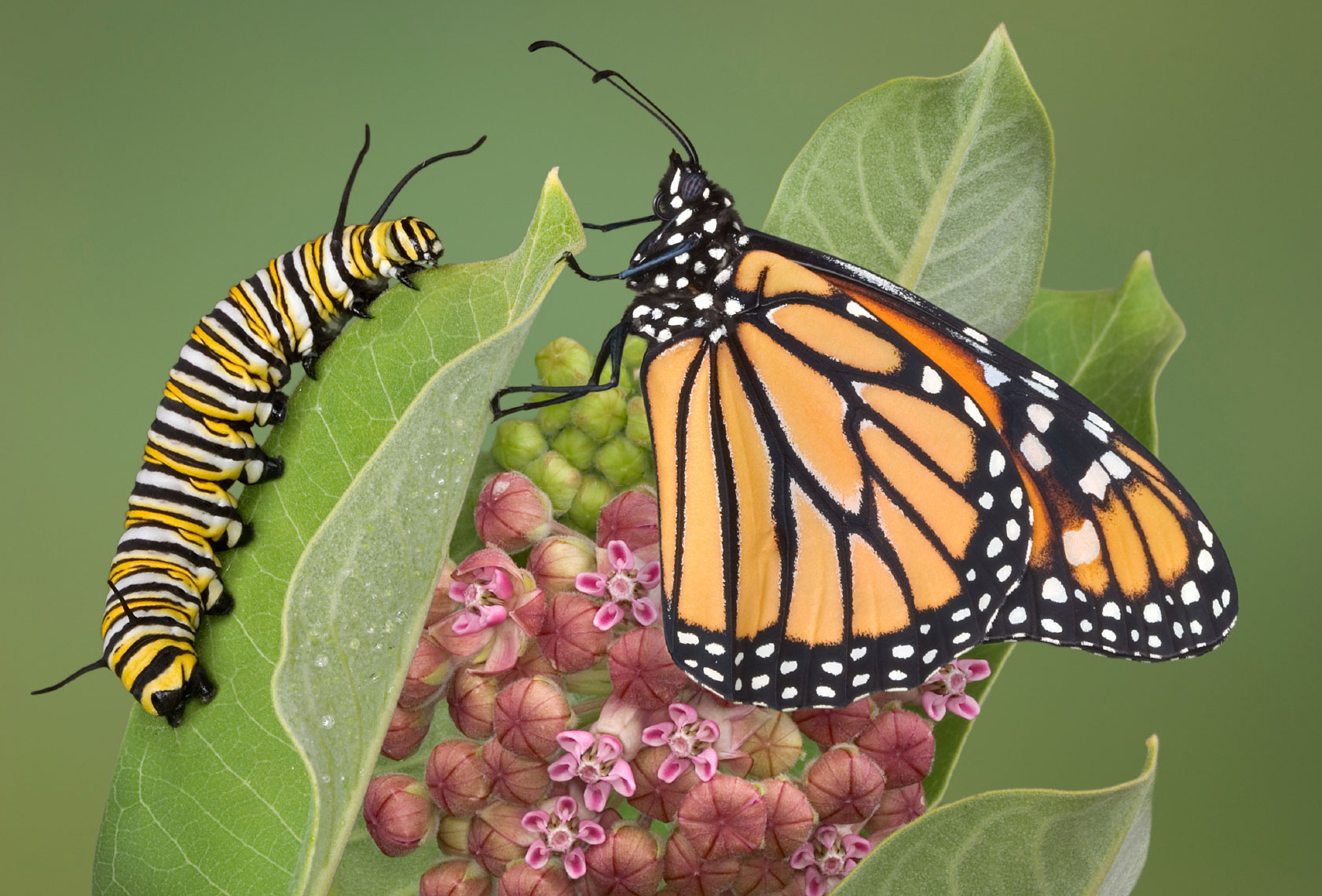
Cracking the chrysalis is one stage in our own metamorphosis, a Greek word that means transformation. It feels like we each wrapped ourselves in a cocoon about March of 2020. We had no idea what was ahead of us. I wonder when a caterpillar wraps itself in cozy silk, if it understands that the silk is going to harden into a casing and that what it believes itself to be when wrapping will never be the same? That’s rather what happened to us. Like the caterpillar, we released life as we had known it – we dissolved – and reformed as something new – or at least we have been offered the opportunity to be a new, best-yet-to-be expression of ourselves. Fortunately, although some of us may feel like our natural circadian rhythm has time-warped into a cicada’s 17-year cycle, it is time to prepare to break out of our chrysalis, to venture into being physically, socially engaged. Much progress has been made so that we can safely enter a new phase of our metamorphosis. For some people who have been pining for physical connection, it’s been way too long. For many others who adapted more deeply to the predictability of life in a cocoon, the prospect of “re-entry” is disquieting, if not outright alarming.
Considering the many changes of this past year in our external circumstances, I don’t know anyone who has declared, “Wow! Can we do this all again?” However, when we look at the personal and spiritual growth that has occurred, I am grateful – even amid the grief.
Ask yourself, “Do I possess a level of faith that makes it possible for me to lean into the unknown in order to have a greater experience of God … am I willing to be transformed?” A hesitant response is a call to dive deep with trust into that perhaps unwelcome nudge by Spirit within – the push-pull urge that lets you know shift is happening. Spirit is pressing you to make a choice and take action. An affirmative answer to the question is a giant step along the path of personal transformation – one phase of a lifelong journey – a journey that is not for the faint of heart. As you courageously lean into your individual transformation, you become a catalyst for universal transformation.
To be willing to transform is the ultimate declaration of faith. In order to open to transformation, we must be willing to let go of all that we know about ourselves, all of the identifiers that are so comfortably reassuring. Far beyond belief that often calls on conditions for validation, surrendering to transformation requires a level of trust that may be challenging. Transformation is described as a thorough or dramatic change in the form, appearance, or character. This is our metamorphosis – the dropping away of what was known. Spiritual transformation requires us to embrace a new identity, a new incarnation of which we may not have an inkling. This is the declaration, “Here I am, Lord. Use me!” without checking it out in advance to see if it is an assignment that meets our worldly concept of ourselves.
The call to transform is the call of Spirit within to align with our Spiritual Truth. It is not a call to build a new you. Nor are you being called to make temporary changes to make it easier to fit into the world around you. The call to transform is the call to come home to being fully alive. The call is to return to our natural state. In his song, “I Return,” David Ault captures what it’s all about:
I return … to the source of my creation,
opening to my place of transformation.
Now I see – Love lives in me.
Come home. Awaken to being boundless Love and Compassion.
